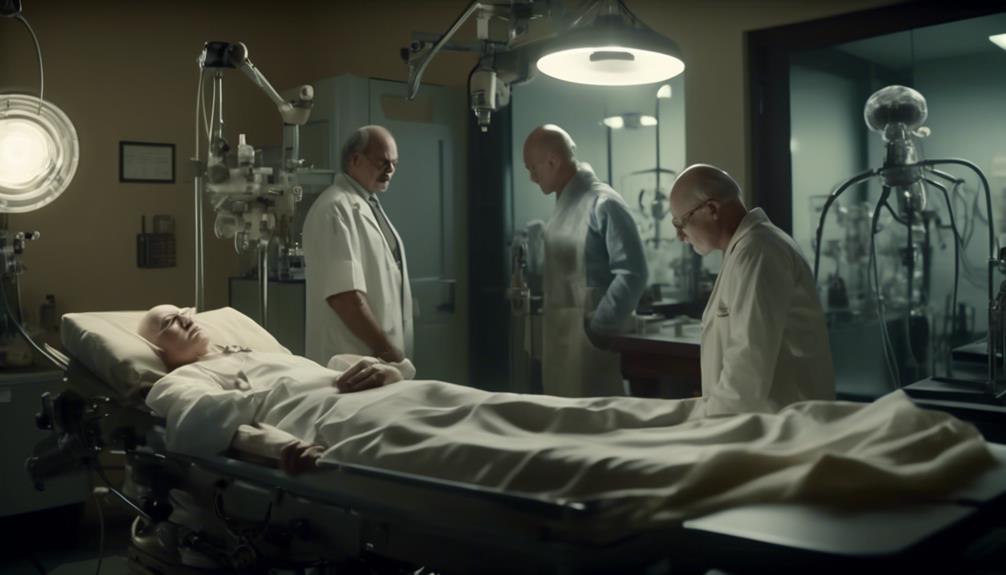Radiation Therapy for Cancer (1896) – Grubbe: Recap and Summary: Early Use of Radiation in Cancer

Emil Grubbe was the first person to successfully use radiation therapy to treat cancer in 1896. This revolutionary development forever changed the landscape of cancer treatment.
Key Takeaways
- Radiation therapy was a significant advancement in cancer treatment during the late 19th and early 20th centuries.
- Emil Grubbe's early use of radiation therapy marked a turning point in cancer treatment, demonstrating the effectiveness of radiation in shrinking tumors.
- Early radiation treatment success revolutionized cancer therapy, laying the foundation for modern radiation therapy techniques such as IMRT, SRS, and proton therapy.
- Despite limitations and challenges, radiation therapy remains a vital component in cancer care, offering improved treatment outcomes and better quality of life for patients.
Historical Background
In the early stages of radiation therapy for cancer, the historical background reveals the pioneering efforts of scientists and clinicians in utilizing this innovative treatment modality.
The advent of radiation therapy marked a significant advancement in the field of cancer treatment. It was during the late 19th and early 20th centuries that scientists began to explore the potential of radiation as a therapeutic option for cancer patients.
The discovery of X-rays by Wilhelm Conrad Roentgen in 1895 paved the way for further experimentation in the use of radiation for medical purposes. It was in 1896 that Emil Grubbe, an American physician, became the first to use radiation to treat a cancer patient. His groundbreaking work laid the foundation for the development of radiation therapy as a viable treatment option.
Over the years, advancements in technology and understanding of radiation biology have led to significant improvements in the effectiveness and safety of radiation therapy. The historical significance of these early efforts can't be overstated, as they set the stage for the development of modern radiation therapy techniques and the subsequent improvement in cancer outcomes.
Emil Grubbe's Discovery
Emil Grubbe's discovery in the early use of radiation therapy for cancer was a groundbreaking breakthrough in medical science. His pioneering work demonstrated the success of radiation treatment in combating cancer, marking a turning point in the field.
Grubbe's discovery had a profound impact on the future of cancer treatment, paving the way for further advancements in radiation therapy.
Grubbe's Groundbreaking Breakthrough
Grubbe's groundbreaking breakthrough revolutionized the field of cancer treatment with his remarkable discovery.
Emil Grubbe's significance lies in his early use of radiation therapy, which paved the way for the development of modern cancer treatment methods. Grubbe recognized the potential of radiation as a therapeutic tool and began experimenting with its application in the late 19th century.
His pioneering work involved using X-rays to treat breast cancer, a radical approach at the time. Through careful observation and meticulous documentation, Grubbe demonstrated the effectiveness of radiation in shrinking tumors and alleviating cancer symptoms.
His findings not only opened up new possibilities for cancer treatment but also laid the foundation for further research and advancements in the field. Grubbe's breakthrough remains a cornerstone of modern oncology, providing hope and freedom to countless cancer patients worldwide.
Early Radiation Treatment Success
Early radiation treatment success revolutionized cancer therapy with its remarkable discovery. The early radiation research conducted by pioneers like Emil Grubbe led to the development of pioneering techniques that proved to be highly effective in treating cancer.
Here are three key factors that contributed to the success of early radiation treatment:
- Precise Dosage: Through meticulous experimentation and observation, researchers were able to determine the optimal dosage of radiation required to target and destroy cancer cells while minimizing damage to healthy tissue. This precision allowed for more targeted and effective treatment.
- Improved Equipment: As early radiation research progressed, there were advancements in the design and functionality of radiation therapy equipment. This included the development of more accurate and reliable machines, such as the Coolidge tube, which increased the precision and effectiveness of treatment.
- Treatment Planning: Pioneers in radiation therapy developed techniques for planning treatment based on the size, location, and stage of the tumor. These planning techniques helped to ensure that the radiation was delivered to the tumor with maximum efficacy, while sparing surrounding healthy tissues.
These early successes laid the foundation for modern radiation therapy, which continues to be a vital component in cancer treatment today.
Impact on Cancer Treatment
The discovery made by Emil Grubbe had a profound impact on cancer treatment. His pioneering work in radiation therapy revolutionized the field and laid the foundation for the role of radiation in cancer treatment today.
Radiation therapy, which uses high-energy radiation to kill cancer cells and shrink tumors, has become an essential component of modern cancer treatment.
Over the years, advancements in technology have further enhanced the effectiveness and precision of radiation therapy. Techniques such as intensity-modulated radiation therapy (IMRT), stereotactic radiosurgery (SRS), and proton therapy have allowed for targeted delivery of radiation, minimizing damage to healthy tissues and maximizing tumor control.
These advancements have significantly improved treatment outcomes and quality of life for cancer patients, providing them with increased freedom and hope for a brighter future.
Techniques Employed by Grubbe
Grubbe employed a technique known as deep x-ray therapy, where he placed metal filters on the patient's skin to protect healthy tissue and focused the x-rays directly on the tumor. This approach yielded promising results, with many patients experiencing significant tumor shrinkage and reduction in pain.
The efficacy of Grubbe's technique was further supported by long-term follow-up studies, which showed that a significant number of patients achieved long-term remission.
Grubbe's Treatment Approach
Grubbe's treatment approach revolutionized radiation therapy techniques, employing innovative methods to target and eradicate cancer cells. His approach aimed to maximize treatment outcomes and improve patient experiences.
Here are three key aspects of Grubbe's treatment approach:
- Customized Treatment Plans: Grubbe recognized that each patient's cancer is unique, requiring tailored treatment plans. He meticulously analyzed patient records and utilized imaging techniques to identify tumor size, location, and surrounding tissues. This data guided him in determining the optimal radiation dosage and treatment duration.
- Early Detection and Intervention: Grubbe emphasized the importance of early cancer detection. By identifying tumors in their early stages, he could administer radiation therapy when the cancer cells were most vulnerable and localized. This approach significantly increased the chances of successful treatment outcomes.
- Continuous Monitoring: Grubbe implemented a system of regular check-ups and follow-up visits to closely monitor patients' progress. This allowed him to adapt treatment plans as necessary and ensure optimal radiation dosages were maintained throughout the treatment period.
Grubbe's treatment approach revolutionized radiation therapy by prioritizing individualized care, early intervention, and diligent monitoring, ultimately enhancing treatment outcomes and improving patient experiences.
Results and Efficacy
Building upon his innovative treatment approach, Grubbe employed specific techniques to assess the results and efficacy of radiation therapy for cancer. Through meticulous observation and documentation, Grubbe carefully tracked treatment outcomes and researched findings to evaluate the effectiveness of radiation therapy. His pioneering efforts laid the foundation for evidence-based medicine in radiation oncology.
Grubbe's meticulous approach involved closely monitoring patients' responses to radiation therapy. He recorded the size and characteristics of tumors before and after treatment, noting any changes in their growth patterns. Grubbe also assessed patients' subjective experiences, such as pain levels, and correlated them with treatment outcomes.
Early Clinical Applications
Early clinical applications of radiation therapy for cancer were groundbreaking in their ability to target and treat malignant tumors with precision and effectiveness. These early clinical trials paved the way for significant advancements in the field of radiation oncology, revolutionizing cancer treatment.
Here are three key aspects regarding the early clinical applications of radiation therapy for cancer:
- Treatment Planning: During this period, treatment planning involved meticulous calculations and radiographic imaging to determine the optimal dosage and target area for radiation. This allowed for the customization of treatment plans based on the specific characteristics of each patient's tumor, leading to improved patient outcomes.
- Radiation Delivery Techniques: Early clinical applications saw the development and refinement of various radiation delivery techniques. This included the use of X-ray machines and radioactive isotopes to administer radiation directly to the tumor site. These techniques enabled precise targeting and minimized damage to surrounding healthy tissues, enhancing treatment efficacy.
- Palliative Care: In addition to curative intent, early clinical applications of radiation therapy also recognized its potential for palliative care. Radiation was used to alleviate pain and symptoms associated with advanced-stage cancers, providing patients with a higher quality of life and improving their overall well-being.
These early clinical applications of radiation therapy laid the foundation for the remarkable advancements we see in cancer treatment today. With continued research and technological advancements, radiation therapy continues to evolve, promising even better outcomes for patients in the future.
Impact on Cancer Treatment
Radiation therapy has had a profound impact on the treatment of cancer, revolutionizing the field of oncology and providing patients with a highly effective and targeted approach to fighting malignant tumors. This therapy utilizes high-energy radiation to destroy cancer cells and shrink tumors, offering a range of benefits for patients. However, it is important to consider the potential long-term effects and radiation side effects associated with this treatment.
To understand the impact of radiation therapy on cancer treatment, let's examine the benefits and potential risks in a table format:
| Benefits of Radiation Therapy | Potential Risks of Radiation Therapy |
|---|---|
| Highly effective in killing cancer cells | Long-term effects on healthy tissues surrounding the tumor |
| Allows for precise targeting of tumors | Radiation side effects such as fatigue, skin changes, and hair loss |
| Can be used as a primary treatment or in combination with other therapies | Risk of secondary cancers due to radiation exposure |
While radiation therapy offers significant benefits in treating cancer, it is essential to consider the potential long-term effects and radiation side effects. The impact of radiation on healthy tissues surrounding the tumor can result in complications, and patients may experience fatigue, skin changes, and hair loss as side effects. Additionally, there is a small risk of developing secondary cancers due to radiation exposure.
Despite these potential risks, the targeted and effective nature of radiation therapy has transformed cancer treatment. It continues to be a crucial tool in the fight against cancer, providing patients with improved outcomes and increased chances of survival. As research and technology advance, efforts are being made to minimize the long-term effects and radiation side effects associated with this treatment, ensuring that patients receive the best possible care and quality of life.
Limitations and Challenges
As we shift our focus to the subtopic of 'Limitations and Challenges', it's important to consider the complexities and obstacles that arise when utilizing radiation therapy for cancer treatment. While radiation therapy has proven to be an effective tool in fighting cancer, it isn't without its limitations and challenges.
Here are three key areas that present challenges in the use of radiation therapy for cancer treatment:
- Tissue damage: Radiation therapy works by targeting and killing cancer cells, but it can also affect healthy tissues surrounding the tumor. This can lead to side effects such as skin irritation, fatigue, and in some cases, long-term damage to organs. Balancing the need to destroy cancer cells while minimizing harm to healthy tissues remains a challenge.
- Treatment resistance: Some cancer cells may develop resistance to radiation therapy over time. This can result in a reduced effectiveness of the treatment and the need for alternative approaches. Understanding the mechanisms of resistance and developing strategies to overcome it's an ongoing challenge in radiation therapy.
- Access to radiation therapy: While radiation therapy is an important treatment modality, its availability may be limited in certain regions or for certain populations. Factors such as cost, infrastructure, and trained personnel can pose challenges to accessing radiation therapy, particularly in low-resource settings.
Addressing these limitations and challenges requires ongoing research and innovation in the field of radiation therapy. By understanding and overcoming these obstacles, we can continue to improve the effectiveness and accessibility of radiation therapy for cancer treatment.
Legacy of Grubbe's Work
Grubbe's pioneering work in radiation therapy has left a lasting legacy in the field of cancer treatment. His influential contributions have shaped the way we approach and utilize radiation to fight against this complex disease. Grubbe's innovative use of radiation as a treatment option opened up new possibilities for cancer patients, marking a significant turning point in the history of medical oncology.
Grubbe's influence can be seen in the continued advancements in radiation therapy. His early experiments paved the way for further research and development, leading to the refinement of techniques and the introduction of more targeted and precise approaches. Today, radiation therapy has become an essential tool in the fight against cancer, playing a crucial role in both curative and palliative care.
The future of radiation therapy holds great promise, thanks to Grubbe's groundbreaking work. Scientists and researchers are constantly striving to improve treatment outcomes, reduce side effects, and enhance the overall patient experience. New technologies, such as intensity-modulated radiation therapy (IMRT) and proton therapy, are being utilized to deliver radiation more accurately and effectively, minimizing damage to healthy tissue while maximizing the destruction of cancer cells.
Evolution of Radiation Therapy
The development of radiation therapy has undergone significant evolution over the years, leading to advancements in treatment techniques and improved outcomes for cancer patients. This evolution can be attributed to the continuous development of technology and the implementation of radiation safety measures.
Evolution of technology: The field of radiation therapy has seen a remarkable evolution in technology. From the early days of using X-rays and radium, we now have sophisticated machines such as linear accelerators that deliver precise and targeted radiation doses to tumor sites. These machines have become more efficient, allowing for shorter treatment times and reduced side effects.
Radiation safety measures: With the increased use of radiation in cancer treatment, ensuring the safety of patients and healthcare professionals has become a top priority. Rigorous safety measures have been implemented, including the use of shielding devices, personal protective equipment, and strict adherence to radiation safety protocols. These measures aim to minimize the risk of radiation exposure and ensure the well-being of everyone involved in the treatment process.
Advancements in treatment techniques: The evolution of radiation therapy has also led to the development of new treatment techniques. These include intensity-modulated radiation therapy (IMRT), stereotactic body radiation therapy (SBRT), and proton therapy. These techniques allow for more precise targeting of tumors while sparing surrounding healthy tissues, resulting in improved treatment outcomes and reduced side effects.
Frequently Asked Questions
What Were the Long-Term Effects of Radiation Therapy on Patients Treated by Emil Grubbe?
The long-term effects of radiation therapy on patients treated by Emil Grubbe included improved patient outcomes, such as reduced tumor size and increased survival rates. However, there were also potential side effects, such as radiation-induced skin damage and increased risk of secondary cancers.
How Did the Medical Community Initially React to Emil Grubbe's Use of Radiation Therapy?
Initially, the medical community was skeptical of Emil Grubbe's use of radiation therapy. However, his groundbreaking work paved the way for future treatments, revolutionizing the field of cancer treatment and saving countless lives.
Were There Any Notable Side Effects or Complications Associated With the Techniques Employed by Emil Grubbe?
You may experience side effects or complications from the techniques used by Emil Grubbe in radiation therapy for cancer. These can include skin reactions, fatigue, and damage to surrounding tissues.
How Did Emil Grubbe's Work Influence the Development of Radiation Therapy Techniques Used Today?
Emil Grubbe's pioneering work in radiation therapy had a significant influence on modern techniques and had a profound impact on cancer treatment. His innovative approach laid the foundation for the development of radiation therapy as we know it today.
What Advancements in Radiation Therapy Have Been Made Since Emil Grubbe's Time?
Since Emil Grubbe's time, advancements in radiation therapy have revolutionized cancer treatment. Techniques such as intensity-modulated radiation therapy (IMRT), stereotactic body radiation therapy (SBRT), and proton therapy have improved precision and reduced side effects, providing patients with more effective and personalized care.









